Great Aussie Adventure Part 3
I recently visited the Land of Oz, otherwise known as Australia. I took a gazillion photos on this trip of a lifetime, so I'm breaking them down into four parts. This is my Great Aussie Adventure, Part 3. (Click the images to see larger versions.)
Melbourne (Part 1) • Cairns (Part 2) • Uluru (Part 3) (this page) • Sydney (Part 4)
After visiting the rainforest and Great Barrier Reef in Cairns, we flew to Uluru. My travel companion Nancy and I took advice from my friend Narelle Todd, book business and marketing consultant extraordinaire, and booked a touring company package to see (and hike) the Very Big Rocks. These have been sacred to the Australian indigenous peoples for upwards of 70,000(!) years, but their official geographic names were given by the European explorers who “discovered” them in the 1800s. That's changing, slowly, as Australia acknowledges the original owners of the land and the Ananu names and traditions for these geologic wonders.
Central Australia, a.k.a. the Red Centre, has hellfire hot high temperatures in the long summer and uncomfortably low temperatures in the shorter winter. We were there in Australian fall, so our weather was a happy medium and great for being outdoors. We did a lot of hiking.
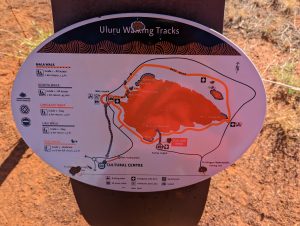
The Great Aussie Outback
Australians use the “outback” to mean the largely uninhabited areas in the middle of Australia. With scarce water and resources, the land simply can't support populations of very many animals, including humans.
Unfortunately, one non-native species has done and continues to do a lot of ecological damage: camels. They (and their Afghan handlers) were imported to help create the nation's telegraph communications system. After the job was done, the government ordered the camels to be killed. The handlers were understandably horrified and instead drove the camels away from settlements and let them loose. The camels didn't die, they thrived. As of 2023, there are now probably a million or more feral camels roaming the outback. They knock over trees, eat almost anything, and damage waterholes beyond repair. Despite culling efforts and management plans, they're still a problem that needs to be fixed.
On to happier topics. Our first full day in the Uluru (Ayers Rock) area started with a sunrise viewing of Kata Tjuta, one of the three major rock formations in the area. Its European name was Mount Olga, named after a German queen who funded the exploration expedition that found it. The park has helpfully built a viewing platform that lets tourists like us take beautiful photos (when the weather cooperates), but it does mean you have to get up well before dawn to get there in time). We later went on a ranger-guided hike in Kata Tjuta's Valley of the Winds. I took the shorter route, while Nancy bravely took the longer hike to a spectacular lookout.

* * *
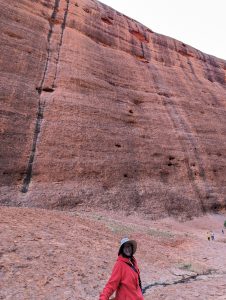
Uluru Resort
Our home base in Uluru was the Ayers Rock Resort, a cluster of five or six hotels with extra restaurants and stores. We tried most of the eateries and did our tourist duty by visiting all the stores. We went back more than once to the art gallery that featured indigenous artwork, including some big enough for a corporate lobby. Alas, we couldn't figure out how to fit our favorite pieces into our luggage. 🙀
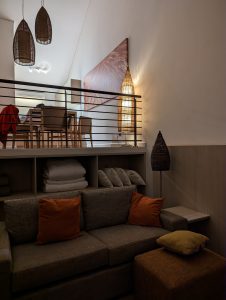
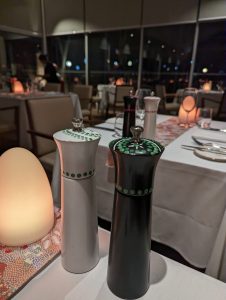
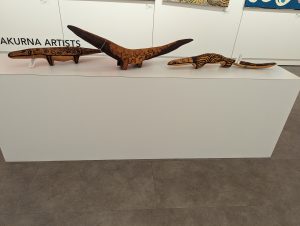
| The view looking up in our very comfortable split-level, two-bedroom apartment in the Uluru Resort. We enjoyed having our own kitchen, and discovered that the sugar ants did, too, when we carelessly left out a spoon used for jam. |
We had our best evening meal at Ilkari Restaurant. I didn't remember to take a photo of the excellent food, but here's a photo of the salt and pepper shakers with hand-painted indigenous themes.
|
I was utterly charmed by the wood carvings of lizards by indigenous artists. These were in the Makurna Art Gallery in the Ayers Rock Resort. |
Adventure Hikes in Aussie Land
Hiking is the thing to do in and around Kata Tjuta Park. Some people rent Jeeps and drive themselves, and some tours offer Segways. I refuse to get behind the wheel of any vehicle in Australia because I'd be a menace the second I forgot to drive on the left side of the road. I've also never learned to ride a Segway, so it was five days of walking for Nancy and me.
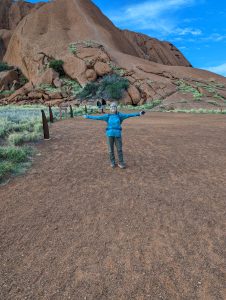
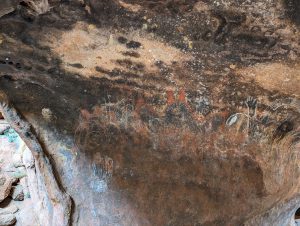
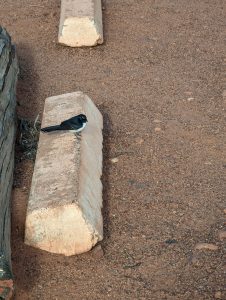
| My travel companion Nancy successfully completed the long walk around the base of Uluru. I chickened out and stuck to the shorter version, so as to keep my knees happy with me. |
Our guide told us the art created here was almost always for information, not artistic expression. In a hard land, a record of food and water sources can make the difference between life and death.
|
This sometimes noisy little bird is called a Willie Wagtail because of its habit of bouncing around and twitching its tail. Tourists often bring food, so the birds are happy to act as a cleanup crew. |



| I got this aerial photo of the leading edge of Kings Canyon, thanks to my first-ever helicopter ride. I would definitely do that again! The hike into the bottom of the canyon was fun, too, but ever so much more work. |
Kata Tjuta park has rest areas throughout, and many have benches like this one made of ironwood. In the 1970s, a rare cyclone pounced on Darwin, the port city to the north, and devastated the forests. These benches were made from the deadfall trees. I'd have bought one for my garden, but the shipping would have broken the bank — these babies weigh more than a thousand pounds each.
|
Artilla, also known as Mount Connor, is sometimes called “Fool-uru” because it can be mistaken for the more famous Uluru. It's still on private land, so we didn't get any closer than this. Just as well; it looks very tall and forbidding. |
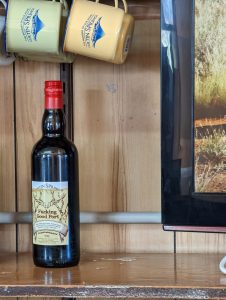
Next post: Sydney








